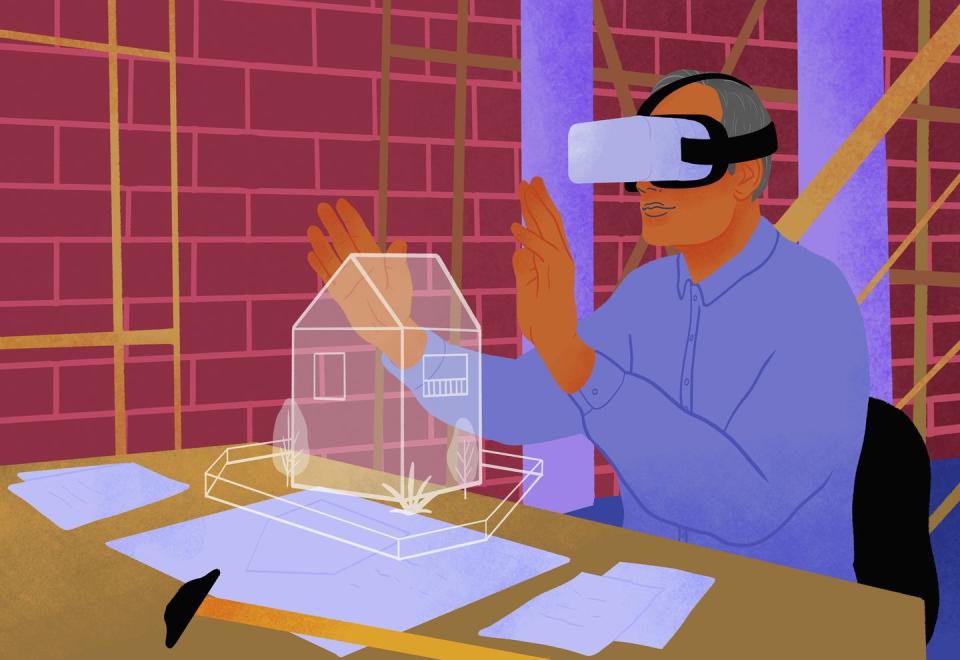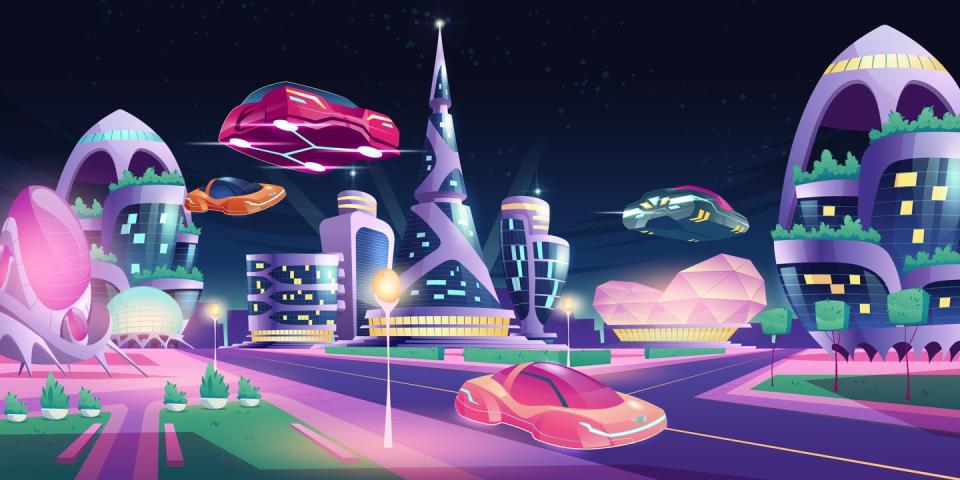Experts reveal what our homes will look like in 2124

Our homes are constantly evolving. We would never contemplate living the same way today as people did a century ago - since then inside toilets, electricity and central heating have all become the norm. And the Good Housekeeping Institute has led the way in testing these innovations in home technology – everything from the first electric washing machines and fridges to dishwashers and microwaves and now the latest robot vacuums and air fryers.
So what kinds of appliances and technology will it be testing in the future? We can’t start to contemplate how our homes will look 100 years from now without considering the environmental and economic crises we currently face. The way we live in 2124 will be a direct response to these. Added to the advances in technology, the continual need for community, and our rising desire for healthier homes and enhanced wellbeing, futuristic visions of clusters of self-contained biospheres don’t seem so implausible!
Over the past century, we've also seen a significant downsizing. According to research carried out by ElectricalDirect, the size of homes in the UK has decreased by 18% over the last four decades, a stark contrast to rocketing house prices, which the same report states have increased by 171% within the same timeframe.

Now, with the popularity of co-living and working spaces taking shape in cities across the world, homes for the next generation could revolve around communal ventures instead of independent residences.
British architect Elsie Owusu, a specialist in conservation working on urban design projects all over the globe, says that our homes should reflect three questions: "How do we live well, how do we live healthily, and how do we live happily?" The pandemic forced us to slow down and change the way we live and work and Owusu believes this will continue.
"Our lives pre-covid were still based on traditional models, where commuters would be packed onto trains at 8.30am and again at 5pm," she says. "However, with remote working taking over and businesses adapting to hybrid models, we need more flexibility from our homes than ever before.' So Owusu believes our homes could increase in size to cater for these added requirements. 'We don’t need huge office towers in the middle of cities anymore," she continues. "However, we will see houses expanding in size to cater for this shift as more people work from home."
Astrid Smitham, co-founder of architecture, design, and research studio APPARATA, meanwhile, believes homes will reflect the needs of a community rather than just individuals. "Future homes have to become more open to letting communities form," she says. "As times get tough, be it through economic or societal pressures, a lot of people will re-evaluate the role of community in their day to day. Take childcare for instance, we used to live in extended family networks but now it’s much harder and more expensive without that support. Homes in both the near, and longer-term, can respond to this in different ways, without being overbearing." She goes on to outline flat shares for elderly residents, for instance, and apartment blocks where tenants share space, equipment and even skillsets.
Grow your own furniture
Architect Bushra Mohamed, the creative force behind London-based studio Msoma Architects, says the materials used will be key in future-proofing homes, especially as weather conditions become more unpredictable due to climate change. "Structures will need to be even more adaptable, with the ability to be completely sealed from the elements in winter, and porous and breathable in summer," she explains. "We will turn back to natural materials such as hemp, timber, and straw for the facades of buildings, while also becoming more effective in adapting our existing building stock. Green spaces, water features and vertical farms (where crops are grown in vertically stacked layers and often under controlled environments) will be integrated into a building’s configuration as our natural landscape is allowed to repair, rewild and rebuild itself."
Design and research studio Material Cultures, which focuses on visionary strategies within a post-carbon built environment, reaffirms the need for homes to be constructed using regenerative, plant-based materials drawn from the surrounding land, while sequestering carbon into the home for as long as it stands.
"Shared communal rooms and gardens will support communities to live flexibly and socially together, set within a productive landscape of food growing and renewable energy production," predicts Summer Islam, one of the three directors at the agency. "At the end of a home’s life, the biobased materials from which it's made can then be returned to the land, to be composted." While these developments are likely to be long term, it does highlight the environmental benefits of temporary organic structures, which could also be conducive to more nomadic lifestyles.
Can you imagine growing your own furniture? It's not as far fetched as it sounds. Design studio Full Grown has been 'growing' wooden chairs for years, training them around custom frames and grafting branches together to create pieces that sit between function and art. Materials such as mycelium and hemp are also being used to created more organic furniture and the Peel Chair, unveiled by the Californian studio Prowl at Milan Design Week last year, was made entirely from a hemp-based bioplastic. And although, at the end of its life, the frame will take up to six months to break down in an industrial composting facility (far less than usual), the hemp foam seat cushion decomposes as fast as an orange peel so when you want to 'refresh' your cushions you can simply compost the old ones at home. With composting facilities also likely to become a mandatory addition to the home, the growing and decomposing of our own furniture is something which, as material innovation continues, could become as commonplace as having a vegetable garden or allotment.
Tackling indoor pollution
Other elements of our interiors will also take a more sustainable 'circular' approach. Low-carbon materials and smart technology combined with structures that respond to the natural ecosystems around them, will become the norm. "A century from now, homes will defy conventional boundaries," states Christian Trahms, founder of tech innovation consultancy In Motion and the creator of Air Shield Mini – a portable and wearable air purifier. "Entire living spaces will exist in a symbiotic relationship within a controlled microcosm – recreating the Earth’s ecosystems within its walls." He goes on to say how smart walls embedded or painted with micro-algae will filter the air, while also engaging in photosynthesis, releasing oxygen, and balancing indoor CO2 levels.

"Intelligent, self-aware nanobots will also purify the air while actively communicating with the external environment, adjusting the indoor atmosphere based on real-time global conditions," he continues. "Picture a home that's a self-contained biosphere, regulating itself continually to create the optimum conditions inside for your comfort and health." And, with visionaries such as Fengfan Yang already harnessing microalgae to power small objects such as a table lamp, it seems we are just scratching the surface of the potential developments that lie ahead.
While homes and workplaces may already appear to be sealed tightly enough to shut pollution out, research is showing that they might, in fact, be shutting pollution in. "Whether we're sleeping, cooking, cleaning, or working, we now spend 90% of our time indoors, breathing potentially dirty air," states Kashyap Chandrasekar, Head of Robotics Research at Dyson. "Our research suggests that the level of particle matter, Volatile Organic Compounds (VOCs) and Nitrogen Dioxide (NO2) are rising in people's homes and our homes will have to respond to this." So appliances in the future will be developed to facilitate healthier environments - something Dyson is already looking at by developing lighting technology to track and maximize the benefits of natural daylight, robotic vacuums to maintain better hygiene levels and air purifiers that automatically sense incoming pollutants.
The predictions of Trahms allude to the increasing importance of health and wellbeing within our homes and how technology will be key to improve this. However, Jo Barnard, founder and creative director of product design and innovation consultancy Morrama, believes that in 50 to 100 years' time, most changes will come from reimagining the things that we've taken for granted for so long. "Take windows for example, they may be the number one mundane object in the world. Yet, it's likely that, in the future, we'll be able to repurpose this portal to the outside world into something that goes way beyond its conventional role. They'll become another smart device that adapts according to our needs, and could even change our view to show any where we'd like to be in the world," she says.
Smart bins for all
In looking at the reinvention of familiar products, Barnard also mentions the way bins will adapt, especially as we strive towards a greener future. "Smart recycling bins will be able to scan our rubbish and automatically identify the types of materials being disposed of," she explains. "This data holds value for both households and recycling facilities. While the latter would have precise information about the types and volumes of components being reintroduced into the economy, homeowners would gain a nuanced understanding of their consumption patterns. Armed with this insight, individuals could then make more conscious choices, fostering a culture of reduced consumption. In this scenario, bins, typically relegated to the final stage of a process, seamlessly integrate into a circular loop of sustainable living."
Our own robots
We've already invited AI into our homes in the form of Google Home and Amazon Alexa, devices which use voice activation to help consolidate multiple devices into one system. As this technology develops, it's easy to see how commonplace design features such as light switches and heating controls will disappear as we no longer need to use them physically and can instead control our home from wherever we are in the world.
If hands-free activation isn’t enough, the integration of domestic help robots to unpack our shopping, or the holographic assistance of a celebrity chef in the kitchen to help us prepare our meals will add another layer of innovation. While these developments might be some years off, the technology already exists and cooking with a virtual Gordon Ramsey not as far-fetched - or far away - as it seems.
Dyson is certain the future is robotic. "We have spent over 20 years developing and researching robotics," Chandrasekar reveals. "Our future vision is of a home that can look after itself, powered by intelligent, efficient technology. Recent advancements in AI, and the ability for robots to learn tasks, are key enablers in getting us closer to this vision."
So, with an ever-evolving world continuing to reshape the way we live, there's no doubt how much our homes are likely to change in response to this. Designers are already starting to think about how to develop housing with communities in mind surrounded by environments that provide fully for their inhabitants, with interiors focused on the best conditions for wellbeing.
And, as Elsie Owusu says, if these developments contribute to healthier and happier homes, where humanity and the natural world can both thrive, then the future looks bright. As ever, whatever developments come, the Good Housekeeping Institute will be there to test them for consumers in the years ahead. Because one thing that hasn't changed in 100 years is our desire to make our lives better and easier.
You Might Also Like


